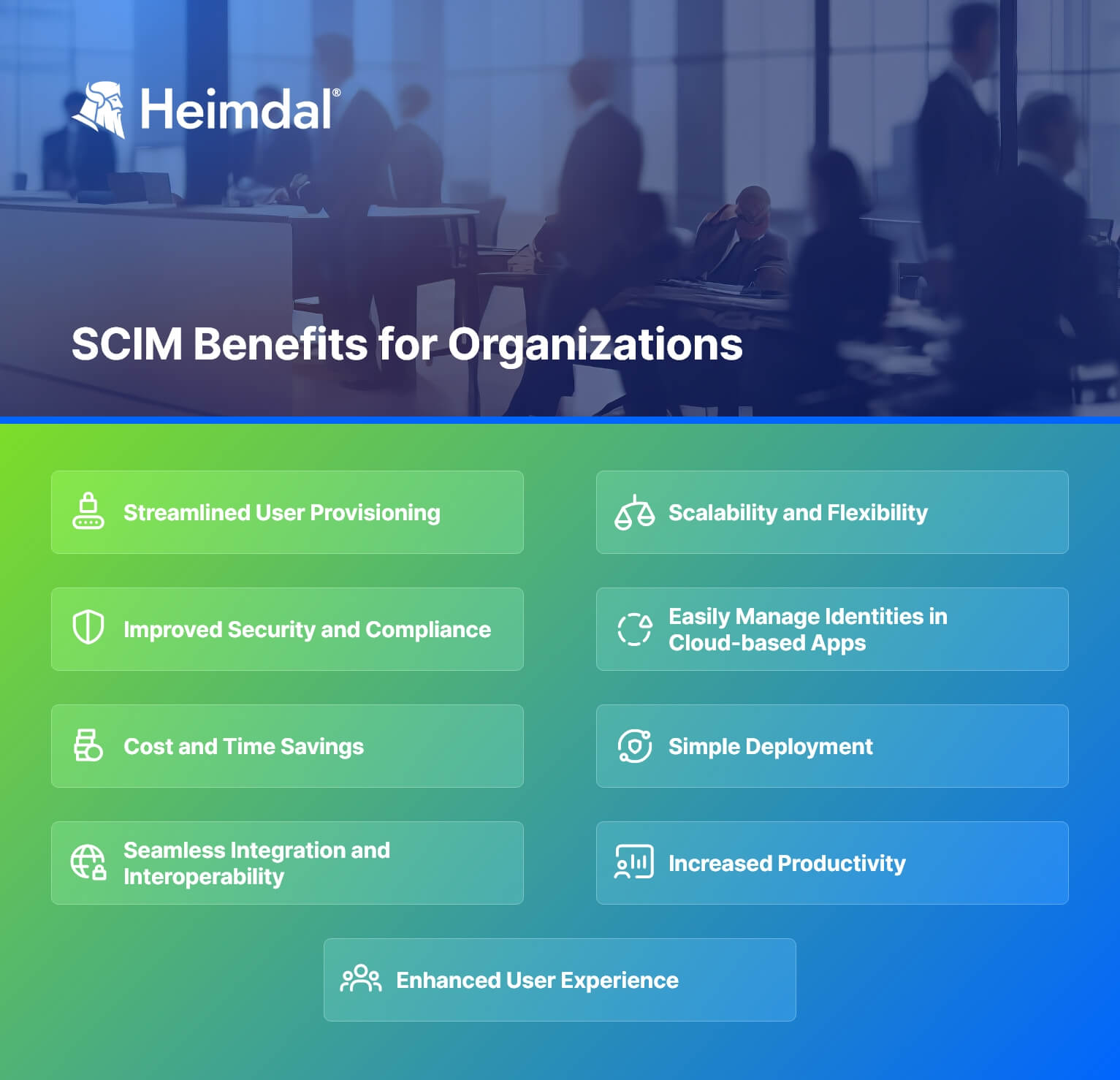Contents:
In the digital age, where enterprises thrive on collaboration and smooth connectivity, user identities and access privileges management has become critical. It’s no secret that manually adding and managing users (also known as user provisioning) can prove a challenging, time-consuming, and error-prone process that leaves room for security weaknesses and inefficiencies.
Also, as more companies use cloud-based services, mobile apps, and a variety of software technologies, the need for a standardized, straightforward, and secure user provisioning system has become increasingly obvious. And here’s where SCIM provisioning comes in handy.
Join me on this insightful journey as I explore the potential SCIM provisioning has for companies aiming to achieve comprehensive Identity and Access Management in the current fast-paced digital environment.
What Is SCIM?
The term “SCIM provisioning,” an abbreviation for “System for Cross-domain Identity Management” provisioning, refers to an open standard that enables organizations to manage user identities, access rights, and entitlements in the cloud safely and efficiently.
SCIM provisioning offers organizations a unified approach to provisioning and deprovisioning user accounts across numerous systems and programs, automating the complex process of user lifecycle management.
Upon SCIM implementation, multiple user accounts can be set up, updated, and even removed with no effort. The right amount of data is transferred from the identity provider (IdP), such as Directories, directly to the SaaS app (service providers) through SCIM, enabling the app to quickly identify users and provide access where necessary without requiring assistance from IT staff.
With the help of SCIM provisioning solutions, organizations can boost productivity, improve security, and enhance overall user management workflows, ultimately enabling smooth collaboration and access control in today’s interconnected digital landscape.
Importance of SCIM Provisioning
Most businesses nowadays need to streamline the sign-in and authorization process since they must manage a complex matrix of tech users.
Additionally, staff members, partners, and independent contractors use their own devices (smartphones and tablets) for job-related activities, and they require to access cloud-based apps and services onsite and offsite with Single Sign-on (SSO). However, user provisioning is necessary for the use of SSO. SCIM addresses this issue by sharing identity data across companies in a standardized manner. It does away with the need for proprietary APIs and handles configuration tasks in a manner akin to how federation standards handle the SSO issue.
Without SCIM, sys admins would need to manually input the user identification data required by the application for those users who are authorized to use it. This manual operation is more time-consuming and has a higher margin for mistakes. Using SCIM as a standard protocol for cloud-based programs and services overcomes this challenge and simplifies user, group, and device management.
How Does It Work?
SCIM proposes a framework for representing user and group identities and offers a REST API to handle identity lifecycles. The Create, Read, Update, and Delete (CRUD) actions on identities are performed through the API using common HTTP request methods (such as POST, GET, DELETE, etc.).
In System for Cross-domain Identity Management provisioning, the client is the organization’s Identity and Access Management framework or identity provider (SCIM IdP), and the Service Provider (SP) is usually a software-as-a-service (SaaS) app, such as Salesforce, for example. The client stores and controls the identities and permissions required by the service providers. In order to keep all systems in sync, SCIM automatically updates the service provider side every time an admin creates, makes changes, or eliminates an account on the client side.
In a SCIM setting, defining vital identity resources allows clients and service providers to safely transmit user identity information. SCIM supports cross-domain interoperability, which enables easy integration with cloud-based apps and compatibility with other enterprise security technologies like firewalls.
SCIM Benefits for Companies
SCIM (System for Cross-domain Identity Management) provisioning has many important benefits for organizations in all sectors. Here are some of the main advantages:

Streamlined User Provisioning
SCIM streamlines and automates user provisioning and deprovisioning across multiple systems and applications. It offers a standardized approach to handling user identities, helping organizations to effectively onboard new employees, allow resource access, and remove access when required.
Improved Security and Compliance
With SCIM provisioning, enterprises can ensure continuous application of access controls and rights. The automation of the provisioning process lowers the possibility of human error and unauthorized access. Additionally, SCIM supports auditing and tracking functions, enabling companies to have increased visibility and control into user provisioning processes, which can be important for regulatory compliance.
Cost and Time Savings
Manual user provisioning, which can be time-consuming and error-prone, is no longer necessary, thanks to SCIM. Companies can save a lot of time and effort by automating this process, allowing the IT staff to work on more important tasks. Additionally, it lowers the overall cost of managing user identities and reduces administrative overhead.
Seamless Integration and Interoperability
System for Cross-domain Identity Management provides a standard API protocol that simplifies integration between identity management systems, programs, and service providers. It ensures interoperability and compatibility across platforms, making it simpler for organizations to adopt and manage multiple and diverse apps while maintaining a unified user provisioning process.
Enhanced User Experience
SCIM enables new employees to be onboarded more quickly and efficiently. It ensures that users have prompt access to the assets they need to complete their tasks, which reduces delays and frustration. Furthermore, SCIM allows for rapid and effective deprovisioning when an employee departs the company, thus ensuring that access to confidential information is immediately revoked.
SCIM provisioning additionally includes Single Sign-On (SSO), which allows users to access their authorized suite of apps by signing in only once during a session with a single set of credentials. It makes everyday tasks more user-friendly while minimizing risks such as forgotten or repeated passwords.
Scalability and Flexibility
System for Cross-domain Identity Management is created to handle large-scale user provisioning needs. It is scalable, making it suitable for enterprises of all sizes and stages of growth. SCIM’s flexibility allows for customization to meet specific business requirements, allowing organizations to customize the provisioning process to their specific needs.
Simple Deployment
SCIM deployment is pretty straightforward, and implementing it won’t require a significant system overhaul.
Increased Productivity Across the Company
Besides freeing up IT teams to focus on more valuable tasks, System for Cross-domain Identity Management, in partnership with access management, reduces the time needed to grant access to backend infrastructure, giving employees a productivity boost.
SCIM vs. SAML vs. SSO
SCIM vs. SAML
Security Assertion Markup Language, also known as SAML, is an XML-based protocol that provides authentication based on the user credentials that are kept in a company’s Identity and Access Management (IAM) system. Despite the fact that the global SAML market is expanding and that it offers a simple way to regulate access to corporate resources, it is an ineffective system when used by itself for cross-domain identity management.
Enterprises that employ cloud-based services need a method for controlling user access to assets in the domains of external providers. Access to all of an organization’s services and applications can be automated with the help of SCIM provisioning. Without SCIM, IT teams would have to spend a lot of time and effort manually creating and managing external user accounts.
SCIM vs. SSO
SSO is an authentication method that allows users to access multiple apps with a single set of login credentials, usually usernames and passwords. It enhances protection and eliminates the need for users to memorize a separate set of logins for each application they use.
While SCIM and Single Sign-on (SSO) complement one another, they each have a distinct purpose. In contrast to SSO, which carries out SCIM authentication by confirming users’ credentials, SCIM offers a straightforward way for provisioning users’ access across many domains.
What Does Heimdal® Bring into the Whole Identity Security Landscape?
As we saw in this article, SCIM, or System for Cross-domain Identity Management, allows for the automation of user provisioning and deprovisioning, which are two processes that are key components of the Identity and Access Management (IAM) framework.
Heimdal recommends integrating Privileged Access Management within your IAM strategy and comes up with a cutting-edge PAM solution – Privileged Access Management – that helps organizations easily handle user rights while enhancing their endpoint security. As it’s the only tool to auto-deny/de-escalate admin rights on infected machines (if you add the Application Control module into the mix), it substantially increases cybersecurity in your organization.

Heimdal® Privileged Access Management
- Automate the elevation of admin rights on request;
- Approve or reject escalations with one click;
- Provide a full audit trail into user behavior;
- Automatically de-escalate on infection;
Wrapping Up…
In conclusion, SCIM provisioning is a robust security tool for managing user identities and access control in modern organizations. By simplifying user provisioning and deprovisioning processes across multiple systems, this solution enables efficient and safe management of user accounts, minimizing administrative burdens and boosting overall security.
Due to its standardized approach, it can be seamlessly integrated with other identity management solutions, making it a valuable tool for companies of all sizes. With the increasing significance of identity and access management in today’s digital world, adopting SCIM provisioning gives companies a pathway to increased productivity, streamlined processes, and strong security measures.
If you liked this article, follow us on LinkedIn, Twitter, Facebook, and YouTube for more cybersecurity news and topics.


 Network Security
Network Security
 Vulnerability Management
Vulnerability Management
 Privileged Access Management
Privileged Access Management
 Endpoint Security
Endpoint Security
 Threat Hunting
Threat Hunting
 Unified Endpoint Management
Unified Endpoint Management
 Email & Collaboration Security
Email & Collaboration Security










